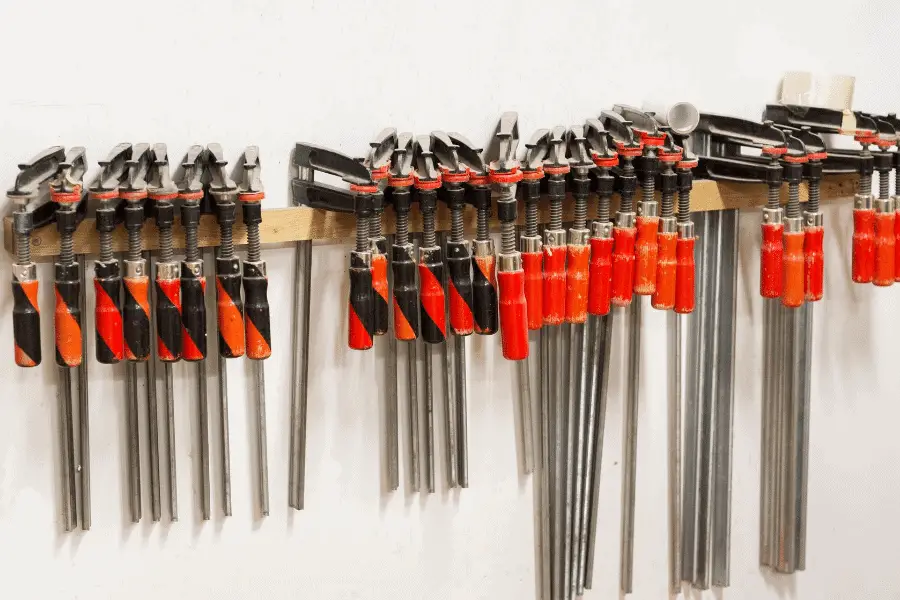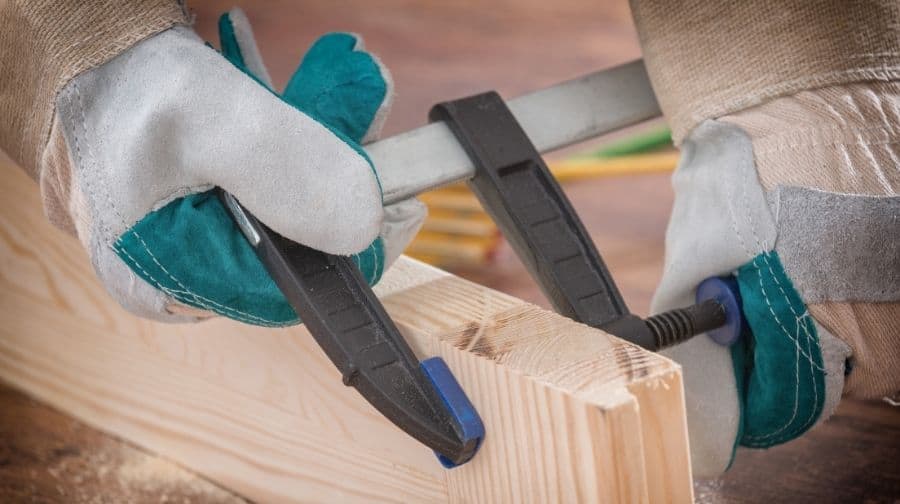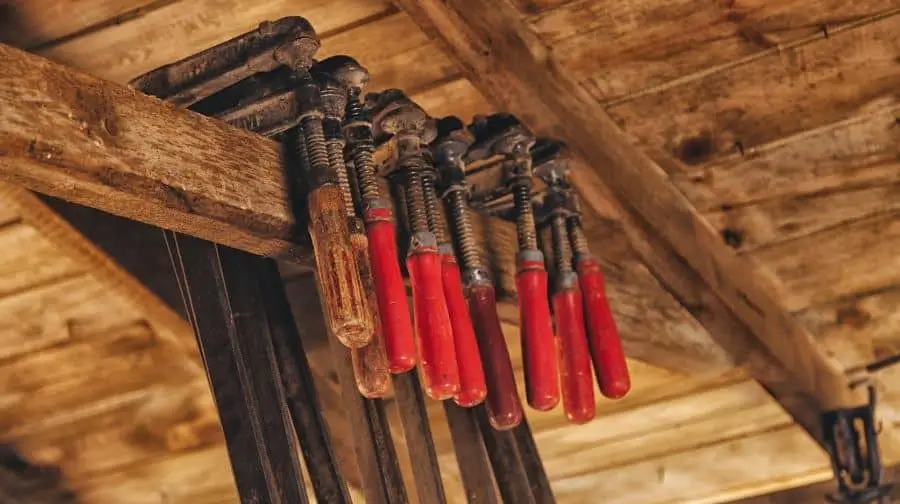
A bar clamp is made up of two horizontal bars joined together by a vertical bar. It is a very essential accessory for the majority of woodworking and several metalworking projects. It makes the work very efficient and speeds up the process.
There are so many helpful options when it comes to clamps for your project. Each clamp has a specific purpose and function that separates it from the others. I’ve researched through the internet and put together a quick summary on bar clamps.
What is a bar clamp used for? Bar clamps also known as F-clamps are mainly used for woodworking glue up projects like doors, tabletops, furniture, and of course, cabinets and also can be used in welding projects.
Keep reading below to learn more about bar clamps and what they can be used for.
Recommended Resource: Free “Art Of Woodworking” Guide
What Is A Bar Clamp Used For?
A bar clamp is a piece of equipment used in woodworking or metalworking projects to keep pieces of wood or metal securely in place so that you can join them together permanently. It will make sure the workpieces are secured tightly so they do not move around and create problems for you while you are working on them.
A bar clamp could also be referred to as a speed clamp or an F-clamp because it looks like the letter ‘F’. Bar clamps are commonly used in pairs but for larger tasks, more will be needed. The clamps could either be positioned along the length of the workpiece or its breadth. Some of the clamps might even cross over each other just to ensure the workpiece is tightly secured.
A bar clamp is made up of two horizontal bars joined together by a vertical bar. There is also a large screw on the lower horizontal bar which allows the clamp to be adjusted and tightened.
The bar clamp comprises a long metal bar that is engineered to hold large and heavy pieces together. The bar is usually made from steel or aluminum so it is very strong.
This is why a bar clamp is ideal for clamping heavy-duty materials. The greater the length of the clamp, the bigger and longer the pieces it can hold. The bar serves the purpose of supporting all the other parts of the clamp and holding them all together.
The clamp also comprises two horizontal bars called jaws which do the actual holding of the pieces. They are two square edges that rest on the bar standing parallel to each other. One of the jaws is at a fixed point and the other is moveable.
Curious about What Is A C-Clamp Used For? Please consider reading our article about the topic at this link here https://topwoodworkingadvice.com/what-is-a-c-clamp-used-for/
Recommended Post: Top Woodworking Jokes

How Do You Use A Bar Clamp?
The fixed jaw is laid against one side piece to be secured, and the moveable part, which is the bottom part of the clamp, is tightened to the opposite side of the piece. The moveable jaw slides along the bar and is locked into place when in the desired position by an adjustable screw. This jaw is known as the back jaw while the fixed one is known as the head jaw. The head jaw could also be adjusted by a large threaded screw by simply turning the screw.
The bar clamp could also have a quick-release lever which when pressed, would unlock the back jaw so it could be quickly moved and relocated. This lever is helpful when clamping needs to be done repetitively as part of a long process.
The bar clamps containing quick-release levers will also have holes through the length of the bar where a pin could be inserted to keep the jaw back in place. Once the back jaw is in the right position, the pin is then placed in the hole nearest to the jaw, to prevent it from sliding down the bar.
A lengthening bar could also be attached to a bar clamp to extend the clamping capacity of the device. When it is connected to the clamp, the jaw opening capacity (throat) could be increased by either 900mm or 1200mm, depending on the lengthening bar in use.
There are different types of bar clamps including sash clamps, quick-release bar clamps, pipe clamps, and T-bar clamps. Even though a bar clamp is very helpful in woodworking projects, there are a few downsides.
Bar clamps are naturally quite expensive so you will have to spend good money to get a durable one. Do not try to cut costs and go for a cheaper one as this could result in the clamp creating issues for you while you’re working.
Also, the bar clamp is not ideal for tasks or projects where there is limited space to work or the piece being worked on is quite small. The clamp will be too big or the bar may be too long, and this isn’t good for delicate workpieces.
Bar clamps serve a very essential purpose to cabinet makers as the bar clamps help to retain their product’s integrity. The tool is used in woodworking while more permanent attachment is being made either with screws or glue.
It is the ideal clamp used to make doors, tabletops, furniture, and of course, cabinets. During the creation of these products, the parts will usually need to be glued together or screwed perfectly. The bar clamp makes sure that the workpiece does not taper in its grip, thereby securing the two parts together without any faults.
Bar clamps could also be used in metalworking processes such as welding. It could be used to hold a couple of pieces together while they are being welded. If two pieces are needed to be joined together to form a singular piece, a bar clamp is essential to hold them together while the pieces are being joined, usually with a screw.
Although the major task of the bar clamp is to hold two pieces together before they get joined, it could be used for a couple of other things.
A bar clamp could be used as a regular clamp to hold vice grips to a bench or even to secure a lumber piece while it is being cut or shaped. It could also be used for clamping down edging where it is clung to a huge piece of wood or even particleboard. However, you have to make sure the bar clamp fits the whole width or length of the object before it is clung.
Curious about What Are Corner Clamps Used For? Please consider reading our article about the topic at this link here https://topwoodworkingadvice.com/what-are-corner-clamps-used-for/
How To Clean A Bar Clamp.
To keep the clamp working efficiently, you must keep all the parts clean. Use a dry cloth to wipe the clamp and keep dust and debris off it as this could damage the ability of the tool and stain the workpiece. Also, oil all moving parts of the clamp regularly to keep it in good condition and prevent rust. Make sure you keep your clamp in a safe and dry place.
Without a proper bar clamp, you are likely to face many problems with your project. So purchase a bar clamp today and accomplish much more, much quicker.

Recommended Post: Top Woodworking Memes
What Are The Best Bar Clamps?
What Is The Difference Between C Clamp And Bar Clamp?
A C-clamp is shaped like the letter C and a Bar Clamp also known as an F-Clamp is shaped like the letter F. The bar clamp is more versatile and widely used in woodworking for glue up projects like doors, cabinets, cutting boards, furniture and tabletops. C-clamps don’t open as wide so they are commonly used for welding and smaller carpentry projects.
Homemade Heavy-Duty Bar Clamps
How Do You Use A Ratchet Bar Clamp?
The Rachet bar clamp comes with a quick release handle. You press the quick release lever to get your clamp into position then squeeze the ratchet trigger to apply pressure to your workpiece.
Curious about What Are Quick Grip Clamps Used For? Please consider reading our article about the topic at this link here https://topwoodworkingadvice.com/what-are-quick-grip-clamps-used-for/
Recommended Post: Top Woodworking Resources
What Sizes Are Bar Clamps?
Bar Clamps come in sizes ranging from 4, 6, 7.5, 12, 24, 36, 40, 48 inch lengths.
Bar Clamps VS. Parallel Clamps
Parallel clamps are going to be more expensive but they are more versatile as a clamp. They have a larger clamp face, more clamping pressure, and stand up on their own. Bar clamps are more affordable, have a smaller clamp face, less pressure but can be quicker to set up for your glue up.
Here’s a blog post with more details on Parallel Clamps.
